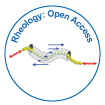Review Article
Rheological Percolation in Thermoplastic Polymer Nanocomposites
Jiji Abraham1, Sharika T1,2, Soney C George3 and Sabu Thomas1,4*1International and Inter University Centre for Nanoscience and Nanotechnology, Mahatma Gandhi University, Kerala, India
2St.Xaviers College Kothavara, Vaikom, Kerala, India
3Centre for Nanoscience and Nanotechnology, Amal Jyothi College of Engineering, Kerala, India
4School of Chemical Science, Mahatma Gandhi University, Mahatma Gandhi University, Kerala, India
- *Corresponding Author:
- Sabu Thomas
International and Inter University
Centre for Nanoscience and Nanotechnology
Mahatma Gandhi University, P.D. Hills
Kottayam, Kerala, 686560, India
Tel: 91-481-2730003
Fax: 91-481-2590357
E-mail: sabuchathukulam@yahoo.co.uk, sabuthomas@mgu.ac.in
Received date: November 30, 2016; Accepted date: December 26, 2016; Published date: January 02, 2017
Citation: Abraham J, Sharika T, George SC, Thomas S (2017) Rheological Percolation in Thermoplastic Polymer Nanocomposites. Rheol: open access 1:102.
Copyright: © 2017 Abraham J, et al. This is an open-access article distributed under the terms of the Creative Commons Attribution License, which permits unrestricted use, distribution, and reproduction in any medium, provided the original author and source are credited.
Abstract
The dispersion of nanofillers in in polymer matrix is a critical issue not only because of its scientific importance but also for technical reasons. Quantitative analysis of extent of dispersion of fillers by measuring the rheological characteristics of thermoplastic polymer nanocomposites has great technical importance for improving processing conditions, for understanding the fundamental characteristics of the materials at the nanoscale and structureproperties relationships of nanocomposites materials and in their commercial applications. Viscoelastic properties including the percolation threshold are extremely sensitive to how the nanofillers are dispersed. The percolation threshold, corresponding to the onset of solid-like behaviour can be observed at lower filler concentrations as the dispersion is improved, or the interaction between the nanofiller and the matrix is stronger or the filler aspect ratio is larger. This review highlights the various factors such as nature of filler, dispersion of fillers, fabrication techniques for polymer nanocomposites, interaction between filler and polymer, filler-filler interactions and temperature which affect the rheological percolation of thermoplastic polymer nanocomposites.

 Spanish
Spanish  Chinese
Chinese  Russian
Russian  German
German  French
French  Japanese
Japanese  Portuguese
Portuguese  Hindi
Hindi